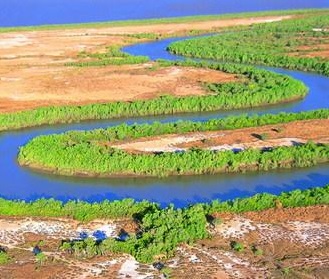Heat-check to gauge river potential
 Researchers will use some novel techniques to assess the state of Australia’s inland rivers, and determine what might result from over-extraction of groundwater in the future.
Researchers will use some novel techniques to assess the state of Australia’s inland rivers, and determine what might result from over-extraction of groundwater in the future.
A number of rivers and streams in the Murray-Darling Basin dried up during droughts in the early 2000s, partly as a result of over-extraction from the aquifers that normally keep them flowing. Now to better understand the problem and water managers secure supplies, researchers at the National Centre for Groundwater Research and Training (NCGRT) are measuring water temperature above and below the surface.
Dr Martin Andersen of NCGRT and the University of NSW says: “We’ve installed data loggers at various points in the Murray-Darling Basin both above and below ground, which are recording temperature changes throughout the day, allowing us much greater insight into the movement of water between streams and underground aquifers... by measuring the rate at which warmer water from the surface trickles into the cooler water below ground we can gain an idea of how quickly or slowly an aquifer is being recharged.”
In shallow river systems natural changes in heat make an ideal indicator for water movement, as information it is freely available and easy to measure. Dr Andersen says the team hopes to gather figures over a long period: “By leaving these loggers in place for long periods of time, we can collect data over many years. This not only helps us build up a consistent picture of water flow in a given area but also means that we can monitor how groundwater levels recharge during floods,” he said.
With government plans flying around to massively increase the agricultural potential of the country’s more arid regions, it may more important than ever to know as much as possible about the massive subterranean reserves. NCGRT managing director, Prof. Craig Simmons says that the full picture of groundwater in Australia has become clear since the introduction of the National Water Initiative.
“If not properly managed, increasing groundwater extraction poses a long-term risk as we generally do not know what effect its removal will have on watercourses at the surface, such as streams and rivers. In order to manage this risk we need to understand how withdrawing water from one area, will affect a water source in another. Using heat to trace water movement is one important method that we have at our disposal to better understand and manage catchment areas such as the Murray-Darling Basin that provide critical sources of water to communities, businesses and ecosystems throughout Australia,” Prof Simmons said.







 Print
Print